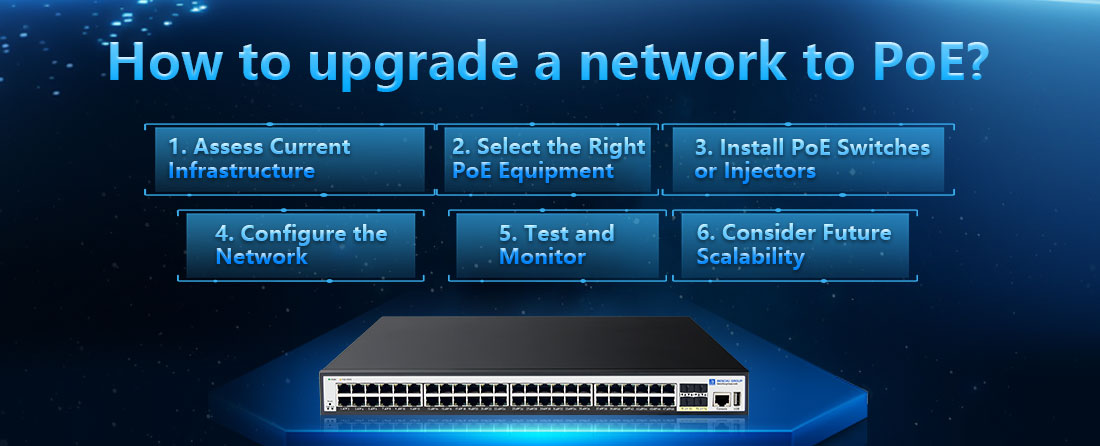
Upgrading a network to support Power over Ethernet (PoE) involves a few key steps, such as assessing your current infrastructure, selecting the right equipment, and configuring the network for PoE devices. Here's a comprehensive guide to help you upgrade your network:
1. Assess Current Infrastructure
Network Devices: Identify which devices you want to power via PoE, such as IP cameras, wireless access points (WAPs), VoIP phones, or IoT devices. Ensure these devices are PoE-compatible.
Existing Cabling: Verify if your current network uses Ethernet cables (Cat5e, Cat6, or higher), as these are required for PoE. PoE can transmit power and data through standard Ethernet cables up to 100 meters.
Power Requirements: Understand the power requirements of your devices. Devices requiring less than 15.4W can use PoE (802.3af), while devices needing more power (e.g., PTZ cameras) may require PoE+ (802.3at) or PoE++ (802.3bt).
2. Select the Right PoE Equipment
Depending on your network size and specific requirements, you can choose between the following:
PoE Switches:
--- Replace your existing non-PoE switches with PoE switches that provide both power and data over Ethernet cables. These come in various port sizes (e.g., 8-port, 16-port, 24-port) and support different PoE standards (e.g., PoE, PoE+, PoE++).
--- Ensure the switch can deliver enough power per port and has enough total power budget for all connected devices.
Examples:
--- 802.3af PoE switch (up to 15.4W per port).
--- 802.3at PoE+ switch (up to 30W per port).
--- 802.3bt PoE++ switch (up to 60W or 100W per port).
PoE Injectors:
--- If you don’t want to replace your existing switches, you can use PoE injectors to provide power to individual devices. A PoE injector sits between your switch and the device, adding power to the data signal.
--- Useful for smaller deployments or when only a few devices require PoE.
PoE Splitters:
--- For devices that are not PoE-compatible, you can use PoE splitters to separate power and data at the device end. This allows you to power legacy devices without replacing them.
3. Install PoE Switches or Injectors
Switch Upgrade:
--- Replace your non-PoE switch with a PoE-enabled switch.
--- Connect your devices (IP cameras, WAPs, etc.) directly to the PoE switch using Ethernet cables. The switch will automatically detect the connected PoE-compatible devices and supply power as needed.
PoE Injectors:
--- For each non-PoE switch port that connects to a PoE device, insert a PoE injector between the switch and the device.
--- Plug the Ethernet cable from the switch into the injector’s data input port and another Ethernet cable from the injector’s data + power output port to the PoE device.
4. Configure the Network
Power Budget Management:
--- Ensure your PoE switch has sufficient power budget to support all connected devices. The power budget refers to the total amount of power the switch can deliver across all its PoE ports.
--- For example, a 24-port PoE switch with a 370W power budget can support multiple devices, but you must ensure the total power consumption doesn’t exceed the budget (e.g., 24 PoE+ devices drawing 15W each).
VLAN Configuration (Optional):
--- If you're deploying IP cameras or WAPs, you may want to separate traffic using VLANs (Virtual Local Area Networks) for better performance and security.
--- Create VLANs for different device types (e.g., surveillance cameras on one VLAN, VoIP phones on another) to segment traffic and improve network management.
QoS (Quality of Service):
--- If you have VoIP phones or video cameras, enable QoS on your PoE switch to prioritize voice or video traffic, ensuring low latency for critical applications.
5. Test and Monitor
Power Delivery: Once installed, test whether your devices are receiving adequate power and functioning correctly.
--- Most PoE switches have LED indicators to show which ports are supplying power.
--- Use the switch’s management interface (if applicable) to monitor power usage and ensure devices are receiving the correct wattage.
Data Connectivity: Test that data connectivity for all devices is working as expected. Verify network speeds and check for any issues with latency or signal strength, especially if you’re running high-bandwidth applications like video surveillance.
Power and Performance Monitoring: Many PoE switches offer management software for monitoring power usage, port activity, and troubleshooting issues like power overloads or faulty cables.
6. Consider Future Scalability
Plan for Expansion: If you expect to add more PoE devices in the future (e.g., additional cameras or access points), choose a switch with enough extra ports and a larger power budget.
Multi-Gigabit or 10G Uplinks: If you anticipate high-bandwidth needs, consider a PoE switch with multi-gigabit or 10G uplinks to prevent bottlenecks as you add more devices.
Centralized PoE Management: For larger deployments, consider using cloud-managed PoE switches that allow centralized configuration, monitoring, and troubleshooting from a single interface.
Summary Steps:
1.Assess your current network infrastructure and identify PoE-compatible devices.
2.Choose PoE switches or PoE injectors based on your network's size and power requirements.
3.Install PoE switches or injectors, connecting your devices via Ethernet cables.
4.Configure the network by managing the power budget, setting up VLANs (if needed), and prioritizing traffic via QoS.
5.Test and monitor the network for power delivery, data connectivity, and overall performance.
6.Plan for scalability by selecting switches with room for expansion and sufficient power budgets.
By following these steps, you can smoothly upgrade your network to support PoE, enabling both data and power to be delivered through a single cable for an efficient, scalable, and simplified setup.